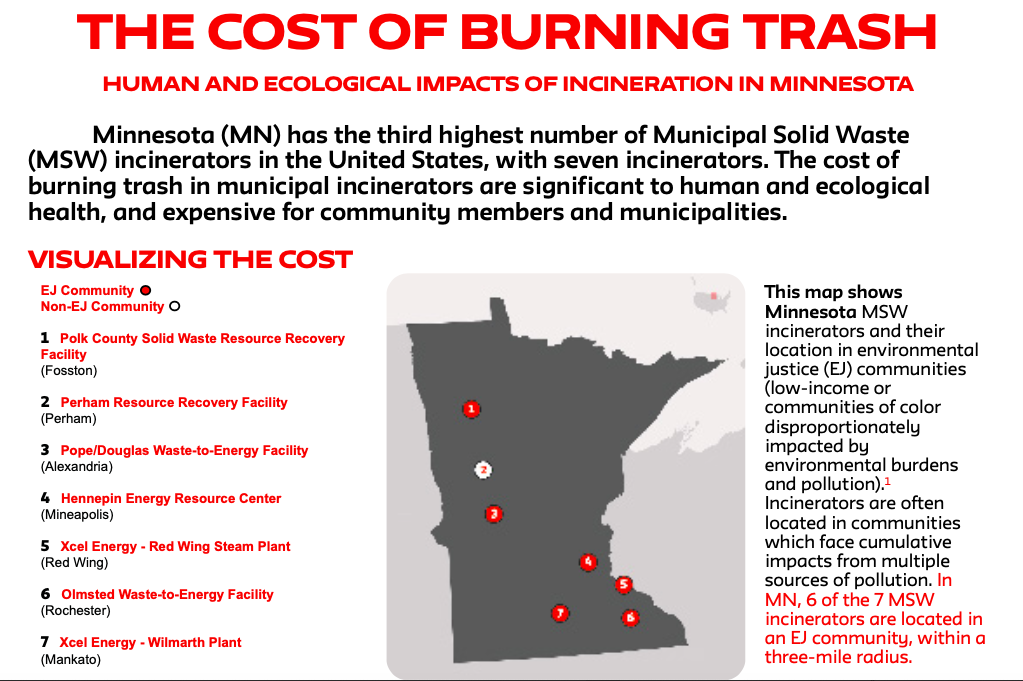Municipal Solid Waste Incinerators are Harmful to Public Health and Environmental Justice Communities2.3 Million Americans in Florida, New York, Minnesota, Massachusetts and Pennsylvania Live Within a 3-Mile Radius of an Incinerator |
New York, December 1, 2020 -- The Tishman Environment and Design Center at The New School has compiled state-specific reports for the five states with the highest number of municipal solid waste incinerators in the U.S. -- Florida, New York, Minnesota, Massachusetts, and Pennsylvania -- that highlight the human and ecological impacts of municipal waste incineration. Across these five states, over 2.3 million residents live within a 3-mile radius of these facilities resulting in constant exposure to significant toxic pollutants. Eighty-one percent of these trash incinerators are located within environmental justice communities. Evidence has linked an increased risk of death from COVID-19 to long-term exposure to particulate matter, a dangerous air pollutant, and the risks from the virus are especially deadly for those living in communities with elevated levels of air pollution. These waste incinerators have been known to emit mercury, lead, particulate matter 2.5 and 10, sulfur dioxide, nitrous oxide, and carbon monoxide, all of which pose significant dangers to public health. The Tishman Center produced fact sheets for each of the five states detailing the effects of the waste incinerators, including updated air pollution emissions data, climate impacts, incinerator affect on local communities, and the economic costs. These state reports are an update to the Center’s early research, U.S. Municipal Solid Waste Incinerators: An Industry in Decline. That study is a comprehensive look at the industry in the U.S. from its rise in the 1980’s to today, and concludes that incinerators are a bad investment for cities. “The current COVID-19 crisis requires us to take a close look at the pollution from this dirty industry,” says Adrienne Perovich, Assistant Director at the Tishman Environment and Design Center at the New School. “State and local officials must reconsider any future incineration investments through the lens of COVID-19 deaths and the disproportionate impacts on environmental justice communities.” In addition to the local community impact, incinerators create major climate impacts through releasing significant greenhouse gases. In 2018, municipal waste incinerators in the U.S. emitted 11 million tons of carbon dioxide, and are nearly as carbon-intensive as burning coal. While many cities have moved away from trash incineration, the facilities that still remain are close to the end of their lifespans, providing an opportunity to transition away from these aging, polluting facilities. Zero waste solutions can be implemented through responsible production, consumption, reuse, and recovery without burning. Cities and states can invest in recycling infrastructure and composting programs, which manufacturers should be accountable for by using and upholding minimum recycled content standards in their manufacturing processes.
|
|
The Tishman Environment and Design Center, as part of The New School, is a university-wide center committed to fostering the integration of bold design, policy, and social justice approaches to environmental issues to advance just and sustainable outcomes in collaboration with communities. The Tishman Center offers technical support to community-based organizations, advocates, and policymakers on the frontlines with an emphasis on supporting the co-production of inclusive, bottom-up approaches that amplify the knowledge and expertise of communities. Visit us as www.tishmancenter.org and follow us on Twitter @NewschoolTEDC. Founded in 1919, The New School was established to advance academic freedom, tolerance, and experimentation. A century later, The New School remains at the forefront of innovation in higher education, inspiring more than 10,000 undergraduate and graduate students to challenge the status quo in design and the social sciences, liberal arts, management, the arts, and media. The university welcomes thousands of adult learners annually for continuing education courses and public programs that encourage open discourse and social engagement. Through our online learning portals, research institutes, and international partnerships, The New School maintains a global presence.
|
 |
MARKETING AND COMMUNICATION |
| 79 Fifth Avenue New York, NY 10003 www.newschool.edu |
PRESS RELEASE |
Media Contacts: The New School |
|
|
